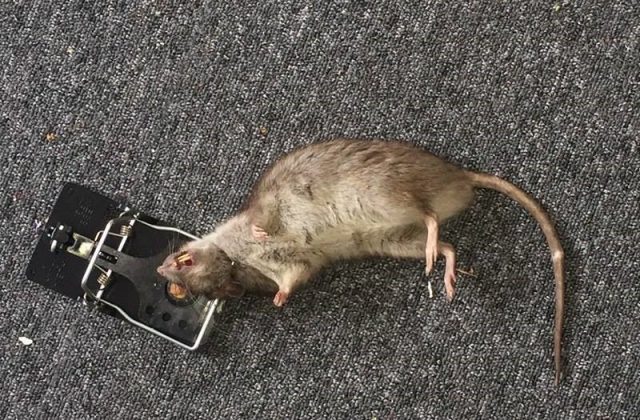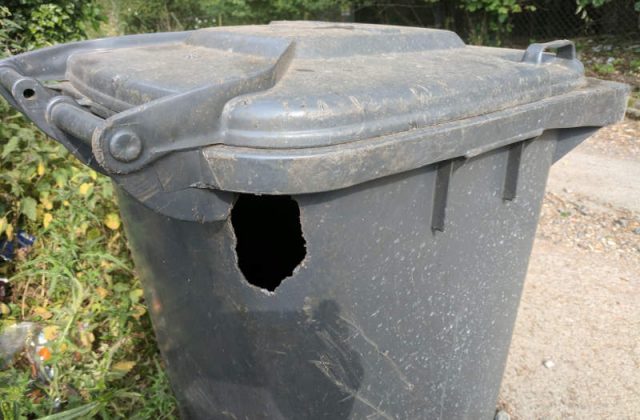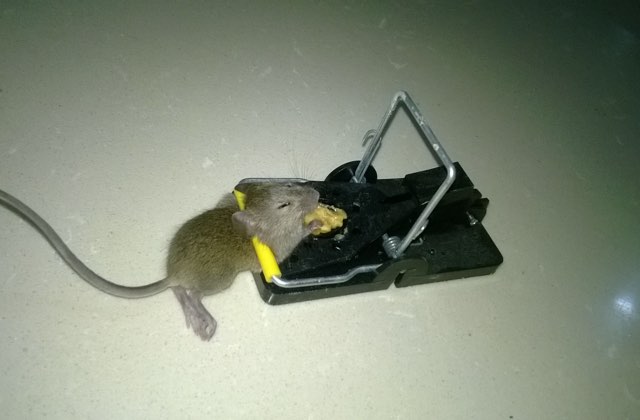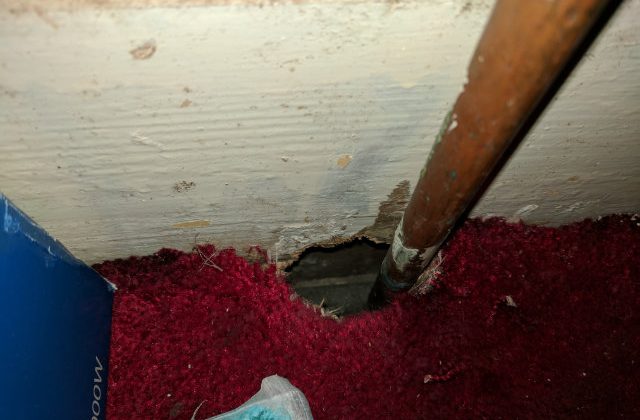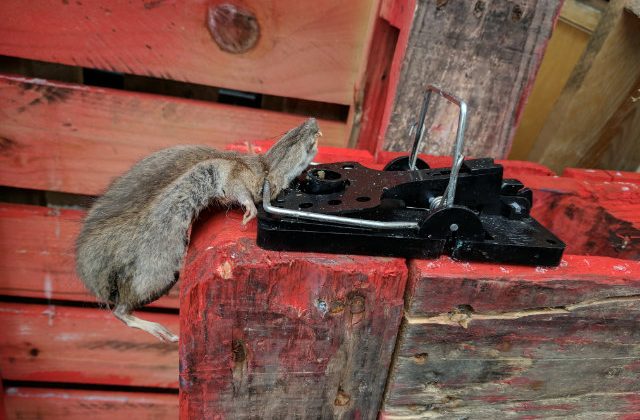Sightings of a rat or of droppings are usually a good sign, Rats are particularly active at night but may be seen during the day searching for food, water or shelter (this usually occurs when their numbers have reached increased to such an extent they are forced to forage for food outside their natural body clock).
Common rat droppings are capsule shaped, tapered at both ends, black and up to 12mm long. A rat will leave about 40 droppings a day. Fresh droppings are soft and moist but we don’t recommend touching them or indeed smearing them over your face.
Runs
Rats follow the same routs when moving around and often leave trails through grass or low vegetation.
Footprints, smears and tailswipes:
These can be seen on muddy or dusty surfaces. Smears are dark greasy marks left on surfaces after repeated contact with the rats body – due to oils contained in rat fur.
Burrows:
Rats can build complex tunnel systems which often extend deep into the ground. Entrance holes are 70 – 120 mm in diameter and can be seen in grassy banks, next to tree roots, at the edge of paving or by drain cover surrounds. Nests: can often be found indoors under floorboards or in lofts.
Gnawing:
Rats gnaw continuously to wear down their front teeth even on non food materials such as electrical cables, pipework and wooden fixtures. This could possibly cause fire or flooding.
Why must they be controlled?
Rats can transmit many diseases to humans, including Salmonellosis, food poisoning and weils disease from the faeces and urine of infected Rats. The fleas that live on rats caused the outbreak of bubonic plague in 1348 that wiped out around half of the entire population of Europe at that time.
Rats may also cause considerable damage to buildings foundations, pipes and cables contained in them due to gnawing and burrowing.
Householders can assist in preventing a Rat infestation by taking a few simple precautions.
- Keep your home in good repair. only need a gap of about 15mm to gain entry.
- Remove potential nesting sites by keeping yards and gardens clean and tidy and by cutting back overgrown areas.
- Ensure that drain covers are in place and in good repair
- Seal gaps around heating and water pipes.
- Ventilation bricks and slots should already have a fine wire mesh incorporated. If this is worn replace it externally with a 3.15 mm insect mesh.
- Do not leave household waste where they can access it, close dustbin lids and composters and do not feed wild birds to excess, you may be feeding too.
How can I get rid of rats?
Rats are adaptable, highly mobile and breed rapidly to produce large rat infestations. This combination can make their control a difficult task for the untrained individual.
If you decide to carry out the work yourself there are two main options – break back traps or poison. Of course both these options can be dangerous to children and pets. Care should be taken when placing traps and the poisons available at hardware stores are not the same as available to a licenced operator so our advice on how to get rid of rats is simple – CALL US IN.
Are Rats Nocturnal?
Rats are in fact mostly nocturnal, so by definition they are technically a nocturnal animal. However optimum availability of a food source can cause them to adapt to daytime living.
Can Rats Swim?
Interestingly this was a very common question that was asked, and the answer is absolutely, yes rats can swim. However, not all rats like to get wet let alone swim! It’s a matter of personal preference for most rats.
Are Rats Intelligent?
Rats are very intelligent animals. They are mammals and In general mammals are by far the most intelligent types of animals on the planet, but did you know that rats are actually considered to be the most intelligent rodents? You can train domestic pet rats to respond to commands, not unlike dogs, and you can teach rats tricks. So quite intelligent.
Can Rats See In The Dark?
Since rats are naturally nocturnal God created them with intelligent mechanisms to see in the dark. Rats mostly see in colour, primarily blue, green and grey. Additionally a rat can see the ultraviolet range of light which, as a human, we can’t. Even under total darkness a rat can spot out other animals, since the ultraviolet light leaves a small glow around objects in the dark.
Are Rats Omnivores?
Rats are omnivores, which mean they can eat the same foods as a carnivore or a herbivore. The diets of omnivores are a little more complex than the diets of herbivores or carnivores.
Are Rats Clean?
No. They are vectors a wide variety of diseases – see diseases.
How do I know if I have a rat infestation?
It is often easier to spot signs of a problem, rather than the actual pest. Rat droppings, scratching noises, Chewing of materials, footprints distinctive smell, rub marks, nests and burrows.
Why are there rats in my house?
Rats in your property doesn’t necessarily mean your place is dirty. Rats are attracted to anywhere there is food, water and shelter. Only small holes are required for a rat to squeeze through.
How do you get rid of rats in the house?
There are common treatments you can undertake such as traps or poisons you buy at local stores that don’t work, but we strongly recommend you call us as we are trained killers and our work is guaranteed. Members of the public don’t have access to the same poisons we do because you have to be trained and pass an exam to use them.
Why do I need to get rid of rats?
Rats are filthy and can spread disease as well as chew anything including pipes and insulation and electrical wires (which can cause a fire and kill everyone in the house). Rat droppings can be hazardous and they leave urine anywhere they go.
The diseases caused by rats are almost too numerous to list but here’s a few to start with
- Leptospirosis. also called Weil’s disease, is an infection you can catch from rats. How you catch it is from the pee of infected animals – most commonly rats, mice, cows, pigs and dogs.
- Hantavirus pulmonary syndrome. (HPS) is a lung infection caused by viruses found in the saliva, urine, and droppings of some rodents. The illness is rare but can be deadly.
- Hemorrhagic Fever with Renal Syndrome. Symptoms of HFRSusually develop within 1 to 2 weeks after exposure to infectious material, but in rare cases, they may take up to 8 weeks to develop. Initial symptoms begin suddenly and include intense headaches, back and abdominal pain, fever, chills,nausea, and blurred vision.
- Lassa Fever. an acute and often fatal viral disease, with fever It is usually acquired from infected rats. symptoms can include:Hemorrhaging, in the gums, nose, eyes or elsewhere. Difficulty breathing,. Coughing, Swollen airways. Stomach ache. Vomiting and diarrhoea (both bloody) Difficulty swallowing. Hepatitis.
- Lymphocytic Chorio-meningitis (LCM) infections can occur after exposure to fresh urine, droppings, saliva, or nesting materials from infected rodents. Transmission may also occur when these materials are directly introduced into broken skin, the nose, the eyes, or the mouth, or presumably, via the bite of an infected rodent. Clinical manifestations range from a flulike illness to severe CNS involvement with meningoencephalitis. Phase 1 of LCM typically manifests as fever and headache, often with lymphadenopathy and a maculopapular rash, resolving after 3-5 days. In many patients, a more severe headache returns within 2-4 days, associated with typical signs of aseptic meningitis. Patients with LCMV infection may report a history of exposure to rodents, hamsters, or the excreta of these animals 1-3 weeks before the onset of symptoms. Infection is most common in the autumn. Smoking is a risk factor.
- Plague: can be a very severe disease in people, with a case-fatality ratio of 30% to 60% for the bubonic type, and is always fatal for the pneumonic kind when left untreated. Antibiotic treatment is effective against plague bacteria, so early diagnosis and early treatment can save lives. It was very popular in the middle ages where it was known as Black Death and it killed between 30-45% of the population between 1348-50. May 1337. There have been other outbreaks since but that was the most serious.
These are just a few of the diseases you can look forward to if you don’t call us and allow a rat or mouse infestation to increase in your house or business
- Some people keep rats as pets. These people are commonly known in the trade as idiots.
Rats have a powerful social chain of command. The largest and strongest rats will get the best food and bedding area - Rats very lovable animals. They love being in the group of their own species or humans. They like playing collectively and love to sleep curled up together. They take care of the injured and sick rats in their group. When rats don’t have friendship, they can become lonely, depressed, anxious and stressed.
- A group of rats is called a mischief.
- Rats are sharp animals. They are more intelligent than rabbits, hamsters, mice, gerbils and guinea pigs for instance. They also have excellent memories. Once rats learn a direction-finding route, they never forget it but our technicians are rumoured to be smarter and use this against them with traps and bait
- Rats are probing but shy. They choose to run away rather than confront a potential threat.
- Romans considered the rat to be a sign of good luck. However nowadays restaurant owners consider them to be bad luck
- Rats have been used throughout history as food for people and pets, religious icons, laboratory animals, pets, mine detectors, animals used in sports (such as the now illegal practices of rat baiting with dogs,) and some have even been trained to drag wires through walls making some electricians’ jobs go much faster.
- Most rats are right-handed.
- Rats do not have any thumbs.
- One of the facts about rats that most people are familiar with is that they can breed quickly. A female rat can reproduce every three weeks or so. And when she gives birth, the litter typically contains six to 10 pups. These pups become sexually mature when they’re three to four months old, meaning they can begin spawning their own broods
- Mongooses were introduced to Hawaii to control the invasive rat population. However, rats are nocturnal and mongooses are diurnal. Hawaii now has a problem with both.
- Giant rats have been trained to sniff out 14,000 landmines and other unexploded arsenals. The rats, which undergo nine months training, are light enough to not trigger the explosives. They literally work for peanuts!
Rats’ front teeth grow 4½ to 5½ inches each year. Rats wear them down by continuously gnawing on everything around them, including cement, brick, wood, lead pipes, and other small animals.



